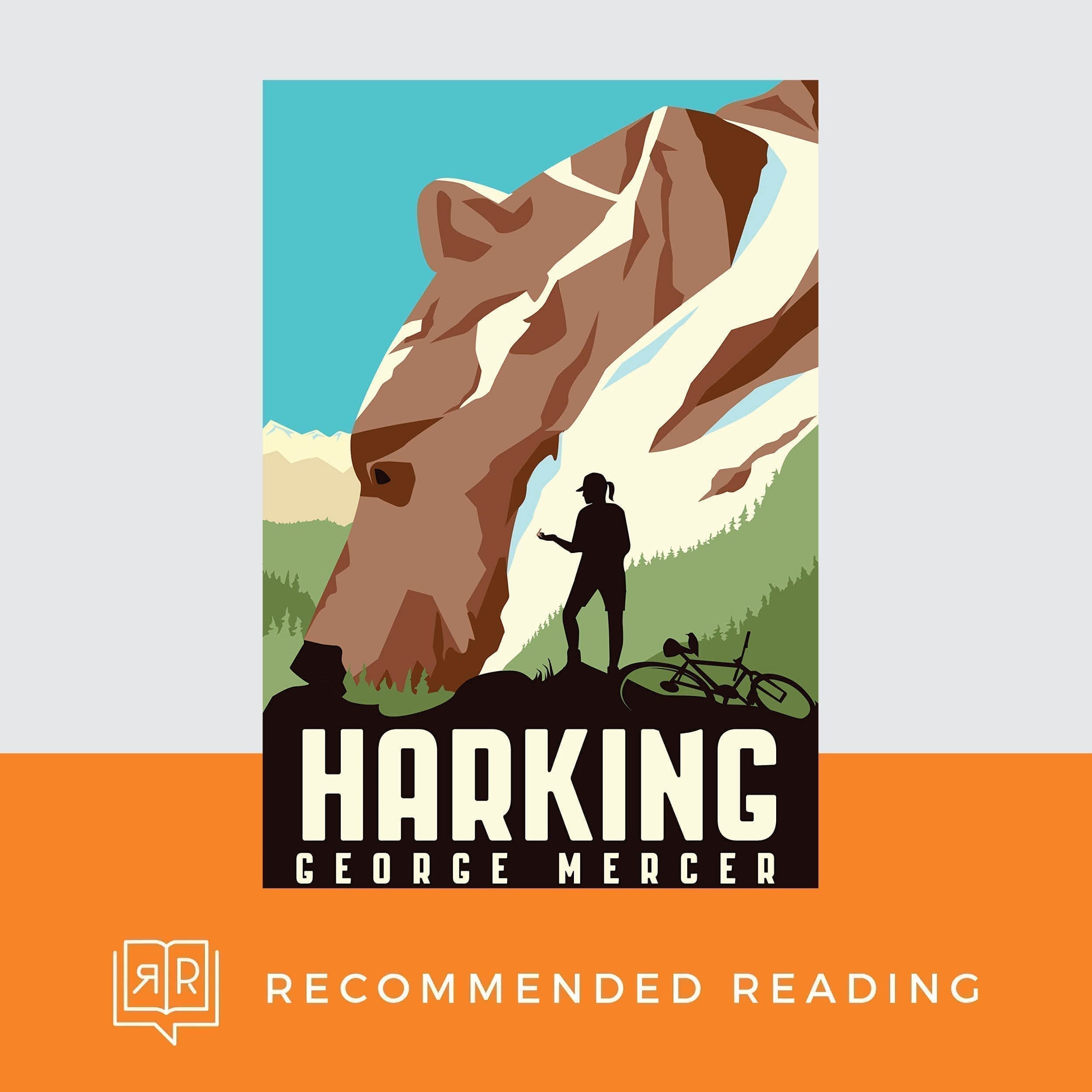Interview: George Mercer, Author of Harking

2018 and 2019 Independent Publisher Book Awards Gold Medalist, George worked for more than three decades as a national park warden in Canada, including work in six national parks on both east and west coasts, the North and the Rocky Mountains.
George is the author of Dyed In The Green, the first fiction series ever written about Canada’s national parks and is also the author of Harking, his first work of YA fiction, also with a national park setting. Harking was long-listed for the 2020 Shelf Unbound Indie Book Awards.
Tell us a little bit about the story of Harking
GM: Harking is a coming-of-age story about 17-year-old Harking Thompson’s fight to save a family of grizzly bears accused of injuring a mountain biker in Jasper National Park in Alberta, Canada. But it’s more than that, as Harking is also trying to find her own path, helped along by an elderly environmentalist who has taken Harking under her wing after the divorce of Harking’s parents and the subsequent death of Harking’s father, who she had gone to live with when her mother decided to leave town with her brother.
Tell us about how the idea of Harking came about.
GM: Unlike my other novels which I wrote to raise people’s awareness about the challenges facing parks and protected areas not only in Canada but in the United States and around the world, the idea for Harking was born from a desire to influence people’s behaviors when visiting and recreating in our national parks, especially the behavior of young adults who will become the next cohort of visitors to these special places.
Harking was also inspired by work we did in Jasper National Park to better understand how our activities were affecting the ability of some species such as grizzly bears to move through a heavily developed part of the park, an area that includes the town of Jasper, the Jasper Park Lodge golf course, and all of the other outlying commercial accommodation in the valley around the town, that supports the millions of people who visit Jasper each year.
That work, which showed us humans were expanding their recreational activities (mountain biking, hiking and horseback riding) into what we considered critical wildlife movement areas, highlighted the challenges of communicating our findings to people and redirecting them away from these critical wildlife areas and back into areas where their impacts were less of a concern. (give some examples and use simple language)
What we discovered in our work was that humans were essentially taking over trails we considered to be wildlife trails exclusively. Most of these efforts were led by local mountain bikers, who having tired of the official park trails where mountain biking was allowed, had decided to build their own trails, not realizing the impacts they were having on wildlife that relied on these trails as secure travel corridors that allowed them to avoid coming into conflict with people.
We were able to show that even low levels of human use (a few people a day) was enough to displace wildlife off these trails, forcing them onto more energy demanding routes higher up on the side slopes of the mountains surrounding the town of Jasper.
Tell us a little about your background and how that has influenced your writing
GM: I worked as a national park warden and biologist in Canadian national parks for more than three decades, working in six national parks from the East coast to the West including the North and the Canadian Rockies. My stories are set in those parks and totally influenced by my experiences working in each of these very unique parts of our country. My passion for parks is what I hope to pass on to readers in a way that is both entertaining and educational, using fiction to hopefully influence and inspire people who might not otherwise read non-fiction or more technical and scientific writing.
I do have other writing interests including:
Dystopian fiction – Repeater is as story about a world where people have disconnected from nature and isolated themselves inside bubbled cities, enacting laws to protect their physical space and banishing repeat offenders of those laws to the wilderness outside the cities.
Humour – The Beaver and The Dick is a somewhat autobiographical story about a young park warden’s evolution in the national park service as he tries to avoid the dictates of the outfit’s politically appointed CEO (auspiciously nicknamed The Beaver) while also trying to decide if he wants to break with tradition and join a newly formed special investigation unit of the recently-armed Park Warden Service (The Dicks).
Westerns – Kid Gloves is about a slightly effeminate, somewhat sophisticated and worldly bank robber with an all-female gang dedicated to exposing an unscrupulous US banking system selling worthless bank notes to unwary citizens, and returning lost money to those people sucked into the scheme. Throughout the story Kids Gloves encounters historically famous characters including Billy The Kid, Sitting Bull, and Sam Steele, a revered Canadian Mountie based along the Canada-US border whose sole purpose is to bring law and order to the newly expanding dominion of Canada.
I have many other writing ideas I hope to pursue, but for now, my interest lies in getting stories out that relate to wildlife and wild places and how we can coexist with them.
Harking explores the emotions and struggles of loss, tell us a little about some of these instances where Harking has to deal with loss and how you handle writing to show those emotions.
GM: Harking initially loses her parents through divorce and ultimately loses her father in an avalanche, which she partially blames herself for. Harking is also emotionally connected to the family of grizzly bears she tries to save and will do everything in her power not to lose them from the national park.
Harking deals with her father’s death and overcomes her grief by trying to follow in his footsteps, using the cryptic notes left behind in his journals to unravel some of the clues both to her family’s past and her own future. Just as she fights to honor her father’s legacy she also fights for the lives of the grizzly bears by speaking up for them to those who make the decisions regarding the bears’ survival.
In order to get inside her head, I would often reflect on how I dealt with some of the losses I’ve experienced in my own life including the loss of parents as well as the loss of a good friend in an avalanche. Like many park wardens and park rangers throughout the world, I’ve also had to deal with many wildlife deaths over the years and those experiences have also helped define my attitudes towards both humans and wildlife and how we might be able to better coexist.
And you don’t win every battle … so I’ve used our own victories and losses in some of the battles we waged as park wardens, (for example, our fight against a proposed slaughter of the park’s entire bison population in Wood Buffalo National Park in the late 1980’s … which we won, … as well as a battle to prevent an open-pit coalmine on the border of Jasper National Park … which we lost) to portray the range of emotions Harking and my other characters experience throughout the story.
What are some of the messages readers will take away from Harking?
GM: I hope Harking will inspire young-adult and adult readers alike to be more conscientious about their actions when it comes to wildlife and wild places, not only within our parks and protected areas but everywhere. I want readers to realize that just as we all face challenges, so do species such as grizzly bears as they try to survive in an increasingly human-dominated world, where our actions, even some of our more subtle actions like where and when we recreate, directly and indirectly impact the very things all species need … secure habitat especially.
I also hope readers, especially young-adult readers will come away with the message that speaking out for the things you believe in can be challenging, but saying nothing does nothing. If we want to improve conditions for the wildlife we share this planet with as well as for ourselves, we need to engage and take action.
What was your favorite part writing Harking?
GM: My favourite part writing Harking was reliving my many experiences working and living in and around Jasper National Park and trying to portray those experiences in a way that would ring true to my readers. I also enjoyed trying to portray the lives of species such as grizzly bears without trying to anthropomorphize the bears. I want readers to appreciate bears as bears and not some human-construct such as they might see in a Disney movie.
I also enjoyed the challenges of getting inside the head of my 17-year-old female protagonist, using what I think I see in our own two daughters as fodder for creating Harking’s character. Another part of this was getting the kids of some our Parks Canada friends to review and provide feedback on an early draft of Harking, which led to pretty substantial changes to the original story, I think improving it immensely.
What is next? Anything in the works now that you can give a sneak peek?
GM: I’m at a bit of a crossroads with my writing since I sent the main character in my Dyed In The Green fiction series about Canada’s national parks to Tanzania, and I have to get him back! The COVID-19 pandemic prevented me from connecting with African rangers and travelling there to research The Rhino’s Horn, the next book in the series, so I pivoted my writing to complete Harking’s story.
I’ve toyed with turning Harking into The Harking Trilogy and based on early response from readers, I think they’d like to see the next two books, which I’ve tentatively titled First, Nature and Second Nature. The titles reflect the need to first protect nature if we really have any hope of enduring as a species and the need to have our consideration of nature and the environment become second nature in everything we do. I know it probably sounds a little corny but I think we have the intelligence and ability to do both.
At the end of Harking I leave my main character considering whether or not working for national parks is the best way for her to achieve what she wants for bears and other species, and I haven’t quite decided where to go with that line of thinking. Harking’s bottom line is the survival of wildlife and wild places and her instincts are evolving as to the best ways to achieve her goals.
Harking also shares some of the same characters as Dyed In The Green, which opens the door to using Harking’s story as a steppingstone for readers to get into the adult series. Completing the trilogy presents opportunities to build on those connections so I need to think about the best way to do that.
Harking
2020 Shelf Unbound Indie Best Award: Long-Listed
After her parents’ divorce and the discovery of a series of cryptic notes left behind after her father is killed in an avalanche, Harking Thompson struggles to come to her own understanding of love, loss and what really matters. Caught up in a battle to save a mother grizzly bear and her cubs, Harking’s fight to protect the wildlife and wild places she loves teaches her a brutal truth: sometimes saving a life might mean losing another you love even more.

[cm_page_title title=”Continue Reading” subtitle=” Shelf Unbound”]
Article originally Published in the February / March 2021 Issue: Young Adult.
